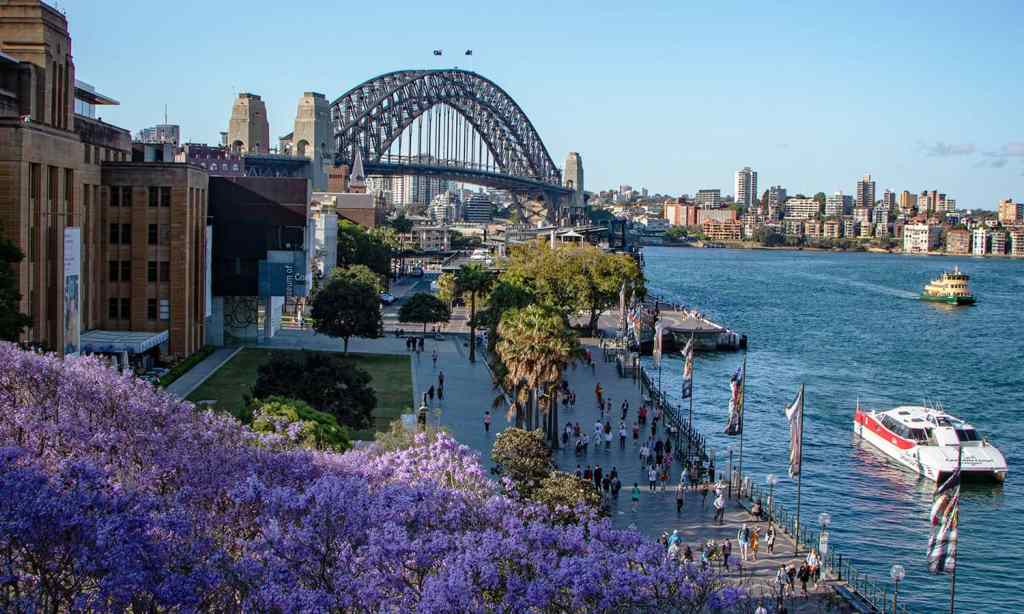Second only to the smell of jasmine in the breeze is the first sign of those glorious purple jacaranda blossoms. Nothing says spring quite like a tree-lined street that rains purple flowers, and Sydneysiders have come to associate the blooms of the jacaranda tree to signify the end of winter — similar to how cherry blossoms are viewed in Japan.
The jacarandas prevalence would have many believe it to be an Australian native, but the variety is actually indigenous to Brazil. As for why it’s so popular in Australia? Well, there are a couple of competing theories.
One old legend attributes Sydney’s mass amounts of jacaranda trees to a hospital matron, who would allegedly send new mothers home with jacaranda seedlings. A perhaps more likely story traces back to the tree being popular during the beautification programs of the early 20th century and interwar years up until the ’50s and ’60s, according to Sydney Living Museums.
However they got to be so prevalent in Australia is something of a mystery, but we’re glad to see the purple plume of the jacaranda every single year. Below, we’re answering all your questions about everybody’s favourite tree, and revealing the very best spots to see the jacarandas in Sydney.
When Do the Jacaranda Trees Bloom?
In Australia, jacaranda trees begin to blossom with rich lavender flowers in mid-October before a peak in mid-November. Soon after, the tree begins to shed its purple flowers to make way for green, feathery foliage.
Where to See the Jacaranda Trees in Sydney
Jacaranda trees are spread far and wide all over Sydney’s suburbs. A drive or stroll through just about any suburban area will present ample photo opportunities, but of course, there are some pockets of Sydney with more trees than others. Below is our city guide to spotting jacaranda trees in Sydney:
In the CBD
Start with a stroll around the Botanic Gardens, which has jacaranda trees dating back to the 1850s. Then, head over to The Rocks and Circular Quay to snap your pic with the Harbour Bridge in the background.
In the North Shore
Sydney’s lower North Shore presents some of the most beautiful photo opportunities for jacarandas. Instagrammers shut down the streets of Lavender Bay and McDougall Street in Kirribilli every year, much to the residents’ dismay. Pockets in Hunters Hill, Woolwich, Greenwich, Waverton, and Wollstonecraft also boast jacaranda blossoms in spades.
In the Inner West
The jacarandas look stunning when juxtaposed by pale, textural sandstone, which may be why so many flock to the University of Sydney campus to spot them every year. While you’re hanging out in the inner west, take a stroll through Glebe, Erskineville and Camperdown for a quieter display.
In the Eastern Suburbs
Paddington turns purple in November, with jacaranda trees lining almost every suburban street. You’ll spot them in the Paddington end of Oxford Street, but the real magic happens as you stroll down Glenmore Road and over towards Five Ways. Other top spots in the eastern suburbs for jacaranda spotting? Woollahra and Double Bay. Vaucluse is another a great spot for a photo op, as you can position the harbour in the background.
South-Western Suburbs
Camden is the ultimate place to spot jacaranda trees. Check out the big collection of jacaranda trees on Argyle Street in the town centre.
Out of Sydney
Grafton on the north coast (around six hours from Sydney) hosts an annual Jacaranda Festival, that in 2023, runs from Friday, October 27 to Sunday, November 5. The town has around 2,000 jacaranda trees that explode with purple flowers and attract a large number of visitors.







